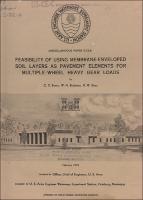Please use this identifier to cite or link to this item:
https://hdl.handle.net/11681/20776Full metadata record
| DC Field | Value | Language |
|---|---|---|
| dc.contributor.author | Burns, Cecil D. | - |
| dc.contributor.author | Brabston, W. N. (William Newell) | - |
| dc.contributor.author | Grau, Robert W. (Robert Walter) | - |
| dc.date.accessioned | 2017-01-17T21:34:31Z | - |
| dc.date.available | 2017-01-17T21:34:31Z | - |
| dc.date.issued | 1972-02 | - |
| dc.identifier.uri | http://hdl.handle.net/11681/20776 | - |
| dc.description | Miscellaneous Paper | - |
| dc.description | Abstract: The investigation reported herein was conducted to (A.) determine the feasibility of using membrane-enveloped soil layers (MESL) as structural elements in flexible pavements and (B.) investigate the performance of MESL construction under multiple-wheel heavy gear load (MWHGL) traffic. A test section was constructed within the existing MWHGL test section at the U. S. Army Engineer Waterways Experiment Station utilizing the existing 4-CBR clay subgrade. The test section consisted of three test items. In item 1, the granular subbase and base and the asphaltic concrete used in the original contruction were replaced with a 24-in. thick MESL. In item 2, the granular subbase and base courses were replaced with a 21-in.-thick MESL that was overlaid with a 3-in.-thick layer of asphaltic concrete. In item 3, a 15-in.-thick MESL was used to replace the original granular subbase material. This item was then overlaid with a 6-in.-thick crushed-stone base and a 3-in.-thick asphaltic concrete surface course. The soil used for the MESL consisted of a lean clay (CL) and was compacted to a relatively high density at a water content slightly less than CE 55 optimum. The compacted soil was completely encased in a waterproof membrane. The subsurface membrane was a 6-mil-thick continuous sheet of clear polyethylene. The surface was formed in place utilizing polypropylene cloth that was field-treated with a cationic emulsified asphalt (ASTM designation C-RS-2). The test items were subjected to traffic with a simulated C-5A main-gear 12-wheel assembly with a 360,000-lb gross load and a 75,000-lb single-wheel assembly. The performance of the test items under traffic showed that the concept of utilizing MESL's as structural elements in pavement construction is feasible. The 24-in.-thick MESL constructed over a 4-CBR subgrade withstood more traffic with the C-5A loading than did a conventional paverrumt item of the same total thickness during the original MWHGL tests. Further work is needed to develop construction techniques and methods of constructing granular bases and asphaltic concrete layers over MESL's. NOTE: This file is very large. Allow your browser several minutes to download the file. | - |
| dc.publisher | U.S. Army Engineer Waterways Experiment Station. | - |
| dc.publisher | Engineer Research and Development Center (U.S.) | - |
| dc.relation | http://acwc.sdp.sirsi.net/client/en_US/search/asset/1048128 | - |
| dc.rights | Approved for public release; distribution is unlimited. | - |
| dc.source | This Digital Resource was created from scans of the Print Resource | - |
| dc.subject | Base courses | - |
| dc.subject | Compacted soil | - |
| dc.subject | Flexible pavements | - |
| dc.subject | Membrane-enveloped soil layers | - |
| dc.subject | MESL | - |
| dc.subject | Multiple-wheel heavy gear loads | - |
| dc.subject | MWHGL | - |
| dc.subject | Subbases | - |
| dc.subject | Design | - |
| dc.title | Feasibility of using membrane-enveloped soil layers as pavement elements for multiple-wheel heavy gear loads | - |
| dc.type | Report | en_US |
| Appears in Collections: | Miscellaneous Paper | |
Files in This Item:
| File | Description | Size | Format | |
|---|---|---|---|---|
| MP-S-72-6.pdf | 67.02 MB | Adobe PDF |  View/Open |